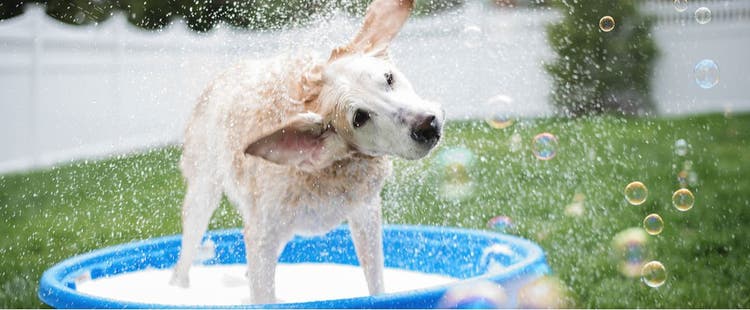
Keep Your Dog Cool This Summer
Summer means vacations, barbecues, and trips to the beach, but pet parents know it also means a host of new pet health risks.
Avoid Heat Stroke and Dehydration
Dogs get dehydrated quickly and are especially vulnerable to extreme temperatures. In addition to keeping your pet hydrated with regular bowls of water, it’s important to recognize and address the signs of an overheated dog. Dogs with heat stroke typically pant excessively and exhibit elevated heartbeats, lack of coordination, and vomiting. If untreated, they may have seizures and fall unconscious. Overweight and elderly dogs are especially susceptible to dehydration and heat exhaustion. Certain dark-haired and flat-faced breeds are at an even higher risk.
Locking your dog in the car is one of the most dangerous things you can do during the warmer seasons. Even if you’ll only be away for a few minutes, this could put your dog’s health at risk and, in certain states, subject you to a fine or arrest.
Protect Your Pooch’s Paws
If the asphalt is too hot for your bare feet, then it’s too hot for your dog’s pads. Keep this in mind during walks and any time your dog will be outside in the heat for an extended period. While walking, stick to grassy, shaded areas as much as possible. Ensure they’ve got a similarly comfortable place to relax if they’ll be joining you outside for summer festivities. Dog booties and socks can also provide an additional layer of protection.
Not much grass on your usual route? Consider updating your schedule to make walks an evening or early morning activity.
Pool Rules
Taking a dip may look like the perfect way for a dog to cool off, but pet parents should keep a few things in mind. First, introducing your dog to swimming should be a gradual process. The American Kennel Club (AKC) recommends carrying the dog into the pool and slowly familiarizing them with its every corner. Teach them how to safely enter and exit the pool and ensure they’re comfortable throughout the process. No, not every dog will take to water. If they look uncomfortable, get them out of the pool.
In general, many of the same pool safety guidelines that apply to children also apply to dogs. You should never leave a dog — even a strong swimmer — unattended. Once they’re safely out of the pool, make sure to rinse your dog’s coat. Chlorine and other chemicals can cause irritation and inflammation after prolonged exposure. Don’t let them drink pool water either!
More Summer Hazards
The sun’s rays are just one of many new risk factors that summer brings. Warmer temperatures also mean more opportunities for your dog to ingest something they shouldn’t. Backyard barbeques provide plenty of chances for the family dog to steal potentially deadly bites. Grilling up hamburgers, for example, could expose your dog to raw meat as well as toxic onions. Make sure to separate your dog from anything that might be harmful and to discourage guests from offering table scraps. Remember, just because a food won’t kill your dog doesn’t mean they should eat it. Even small, unexpected dietary changes can lead to intestinal issues or allergic reactions.
A number of summertime plants are also poisonous to canines. These include gladiolas and sago palms. Their effects range from temporary vomiting and diarrhea to fatal liver failure. To be safe, gardeners and dog walkers should avoid letting their dog ingest any sort of plant. If you believe your pet has eaten a poisonous food or plant, reach out to the Association for the Prevention of Cruelty to Animals immediately.
Ticks and fleas are in search of a meal this time of year, too. Consult with your veterinarian to ensure your dog is protected both indoors and out.
Stay Safe This Summer
Keep these tips in mind to make sure your pup is happy, healthy, and hydrated — even during the dog days of summer.